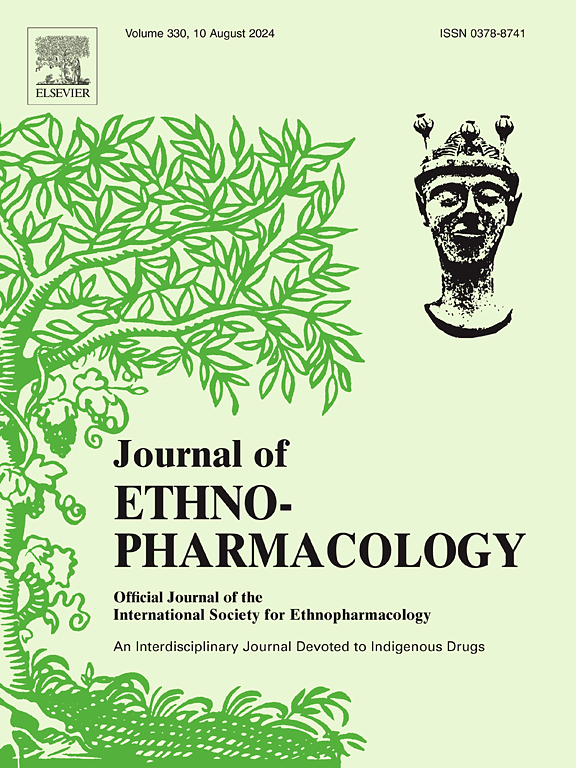LC-MS/MS profiling of Zanthoxylum piperitum (L.) DC. leaves cultivated in Egypt, isolation of its bioactive components, and interrelationships with anti-ulcerative activities: in vitro and in vivo approaches, molecular docking, and dynamics studies
IF 4.8
2区 医学
Q1 CHEMISTRY, MEDICINAL
引用次数: 0
Abstract
Ethnopharmacological relevance
Zanthoxylum piperitum (L.) DC. cultivated in Egypt is a new cultivar of the known anti-inflammatory food spice Zanthoxylum piperitum (L.) DC.
Aim of the study
This study aimed to investigate the new cultivar leaves phytochemically and biologically.
Materials and methods
UPLC-Triple TOF-MS/MS analysis examined the ethanolic extract's composition, and FRAP and ORAC assays evaluated its antioxidant activity. Major flavonoids were isolated and identified by spectroscopic techniques. The anti-inflammatory properties of the extract and isolated compounds were investigated in vitro. Then, by in vivo acetic acid-induced UC model on Sixty-three male Wistar rats at high and low doses compared to standard prednisolone. Evaluation involved macroscopic and microscopic assessment of rectal damage, cytokine measurement, molecular docking, and dynamic simulations to support the findings.
Results
Extract of Zanthoxylum piperitum (L.) DC. Cultivated in Egypt demonstrated rich phenolic content and antioxidant action. Isoquercitrin and quercitrin were isolated and identified via spectroscopy. The in vitro anti-inflammatory tests showed that the extract inhibited COX1 and LOX significantly (p < 0.05). In the in vivo UC model, all treatments ameliorated the macroscopic and microscopic damage in the intestine of UC rats' and improved the biochemical markers in a dose-dependent manner, especially isoquercitrin at a high dose (40 mg/kg) showed the most significant results (p < 0.05) compared to the standard group. Molecular docking and dynamics studies supported these findings.
Conclusions
This indicates the potential of the extract of Zanthoxylum piperitum (L.) DC. cultivated in Egypt and its main constituents for the treatment of UC.
花椒的LC-MS/MS分析直流。埃及栽培的叶子,其生物活性成分的分离及其与抗溃疡活性的相互关系:体外和体内方法,分子对接和动力学研究。
民族药理学相关性:花椒(L.)直流。在埃及种植的是已知的抗炎食品香料花椒(L.)的新品种。直流。研究目的:对该新品种叶片进行植物化学和生物学研究。材料与方法:UPLC-Triple TOF-MS/MS分析测定乙醇提取物的成分,FRAP和ORAC测定其抗氧化活性。通过光谱技术分离鉴定了主要黄酮类化合物。对其提取物及分离化合物的体外抗炎作用进行了研究。然后,与标准泼尼松龙相比,采用高、低剂量醋酸诱导63只雄性Wistar大鼠体内UC模型。评估包括直肠损伤的宏观和微观评估、细胞因子测量、分子对接和动态模拟来支持研究结果。结果:花椒提取物直流。在埃及栽培显示出丰富的酚类成分和抗氧化作用。对异槲皮苷和槲皮苷进行了分离鉴定。体外抗炎试验表明,该提取物对COX1和LOX有显著抑制作用(p < 0.05)。在体内UC模型中,各处理均能改善UC大鼠肠道宏观和微观损伤,改善生化指标,且呈剂量依赖性,其中异槲皮苷高剂量组(40 mg/kg)较标准组效果最显著(p < 0.05)。分子对接和动力学研究支持了这些发现。结论:提示花椒提取物具有开发潜力。直流。种植于埃及及其治疗UC的主要成分。
本文章由计算机程序翻译,如有差异,请以英文原文为准。
求助全文
约1分钟内获得全文
求助全文
来源期刊

Journal of ethnopharmacology
医学-全科医学与补充医学
CiteScore
10.30
自引率
5.60%
发文量
967
审稿时长
77 days
期刊介绍:
The Journal of Ethnopharmacology is dedicated to the exchange of information and understandings about people''s use of plants, fungi, animals, microorganisms and minerals and their biological and pharmacological effects based on the principles established through international conventions. Early people confronted with illness and disease, discovered a wealth of useful therapeutic agents in the plant and animal kingdoms. The empirical knowledge of these medicinal substances and their toxic potential was passed on by oral tradition and sometimes recorded in herbals and other texts on materia medica. Many valuable drugs of today (e.g., atropine, ephedrine, tubocurarine, digoxin, reserpine) came into use through the study of indigenous remedies. Chemists continue to use plant-derived drugs (e.g., morphine, taxol, physostigmine, quinidine, emetine) as prototypes in their attempts to develop more effective and less toxic medicinals.
 求助内容:
求助内容: 应助结果提醒方式:
应助结果提醒方式:


